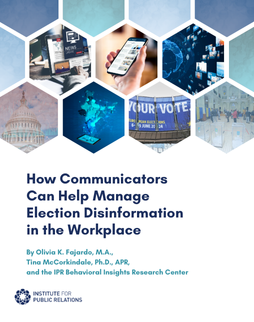
Based on in-depth interviews with CEOs from a variety of industries, the study, conducted by Gotham Research Group, finds that:
- CEOs have a clearer understanding that the corporation itself—and not just the brand, products or services–is under scrutiny by all stakeholders, both internal and external. The interplay of corporate character, corporate reputation and corporate values, and their impact on the business plan, has become a primary focus.
- Speed, transparency and globalization continue to be major factors in staying on top and ahead of communications trends and issues.
- CEOs see social media as a full-fledged, legitimate, if sometimes overwhelming, communications channel.
- CEOs want more hard data-driven, sophisticated communications measurement and interpretation.
- The role, responsibilities and perceived value of the chief communications officer are expanding.
These are encouraging findings and offer ample opportunity for CCOs to further drive meaningful action in their organizations. One key implication is the need for CCOs to master the world of “big data” and its application to the communications function. That’s not just in terms of measuring ROI for communications, but in better understanding specific audiences and predicting trends. Another theme is the CCO as chief collaboration officer, working with the CEO, across the C-Suite and throughout the enterprise, to design and execute results-oriented strategies and plans.
The CEO View updates CEO research that was originally done as part of The Authentic Enterprise (2007), the seminal thought leadership monograph that discussed how authenticity is the key to building and defending brand and reputation in an environment of radical transparency and empowered stakeholders.
In comparing the two studies, we see two important shifts in CEO perception about communications. One is a change in emphasis from defense to offense. In 2007, CEOs saw communications as a way to fight back when the press wrote negative stories. Today, they see the opportunity for the communications function to be more proactive, setting agendas and building engagement across all audiences. CEOs cited the need to build relationships with a wide variety of stakeholders, including employees, customers, journalists, non-profits, regulators, and even the “little old lady who shows up at every annual meeting.”
Second, there is a growing appreciation for the authenticity of companies, people and reputations. CEOs we interviewed believe that most of the time, the decisions and actions of their people genuinely reflect the organization’s values. They are looking for increased openness, honesty, and transparency in the organization’s communications. And, they are beginning to understand that dialogue, and not just “messaging,” is key for truly engaging all audiences.
This is positive news indeed. Perhaps one indication of the increased importance CEOs are putting on communications is the amount of time they spent with us discussing these issues. Many engaged for far longer than the scheduled 30 minute interview.
As one CEO said, “Our CCO is much more influential now. The job used to be more formulaic, certain messages went to a small number of places, the big mainstream players. Now there’s many more outlets, and correspondingly greater impact.”
The CEO View confirms the need for CCOs and their teams to deliver greater impact on an enterprise’s distinct identity and reputation.
Valerie Di Maria is principal of the10company, a New York-based consultancy, dedicated to helping C-Suite executives transform their businesses through authentic, results-driven marketing and communications. She is also a Trustee of the Arthur W. Page Society and co-chairs its Thought Leadership Committee.




First, I applaud the Institute’s commissioning of the research into the thinking of CEOs and congratulate the Gotham Research Group for a job well done.
Obviously, it is good news that some executives at the CEO level appreciate the value of data-driven strategic planning and, further, recognize the importance of openness, honesty and transparency to public members. However, without meaning to be unduly critical, we might ask: “What took so long?”
Unfortunately, at least part of what took so long is, as Pogo might have said, “us.”
For decades, we insisted that PR is more “art” than science and it deals in “image” – a characteristic we said is “difficult to measure.” Additionally, I fear we are on the edge of that dreaded “slippery slope” that leads back to “image” if we continue to endorse the idea as “reputation” as our measuring stick of success.
Further:
* We evaluated our performance in terms of the number of outputs we produced and shunned determination of the more important matter of outcomes.
* We met almost every problem with an barrage of communication(s) vehicles as though production is the answer to every problem.
* We were consumed with the notion of mass publicity, far beyond the time when the fragmentation of the mass media and the splintering of the mass audience showed it to be outdated.
* We underplayed the value of relationships and their role as the central function of PR, and,
* We neglected to prepare those entering the field of the need for an holistic view of PR.
I might add that customers were far out in front of our clients in terms of what constitutes value in the organization-stakeholder relationship. Numerous scholars have found that positive public perceptions of relational “dimensions” such as trust and openness are linked to loyalty toward an organization.
Furthermore, are we seeking to replace PR with notions of a “Chief Communication(s) Officer”? We seem to be talking of PR solely in terms of communication (“symbolic behavior”), without acknowledging the importance of (“actual”) behavior, when in fact symbolic behavior without actual behavior is akin to “talking the talk” but failing to “walk the walk”. As many scholars have pointed out, the role of communication(s) is that of a tool used in managing organization-stakeholder relationships.
Again, I applaud the Institute’s commissioning of the research and congratulate the Gotham Research Group for a job well done, and thank you for the opportunity to comment.
This a very guide article and one that I have been looking for. You see, PR is a new concept here in Botswana. And its role is not best understood by both the CEO and the CCC. The CEO sees it as atool of counteracting the negative reports by the media, but never a tool for setting the agenda. Dialogue is one thing that CEOs wish not to entertain, and CCC/PRs are powereless as normally they in lower positions. This article has actually formed the basis of the training that i have organised for my senior management team in September 2013. THank you so much for “Understanding the CEO view” Valerie Di Maria.